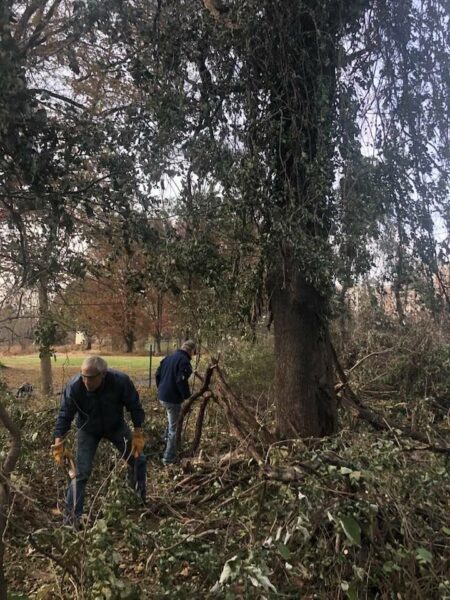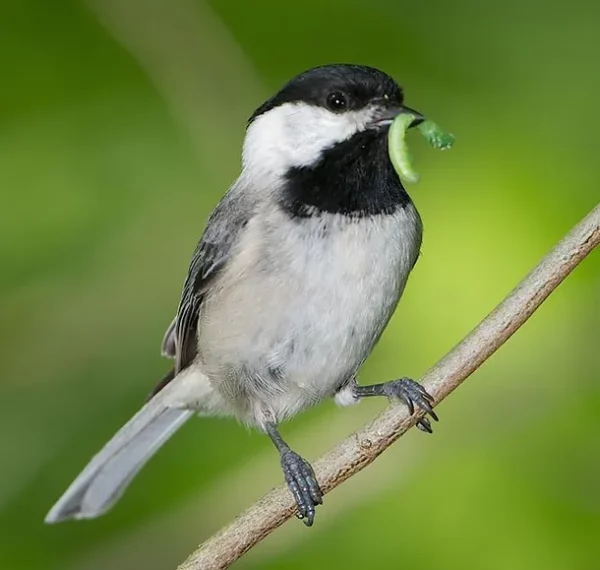by Ray Heil
As a practicing landscape architect, I’ve planted thousands of trees in my career. Planting a tree is always a hopeful experience; we’ve always understood that if we can assure that the new tree is established after the first 3 years, the odds are good that it will continue to grow successfully and confer multiple benefits on the community. But this is no longer true, due to the proliferation of aggressive invasive vines in the urban and suburban areas of Maryland. We’re all familiar with stories about kudzu, “the vine that ate the South,” which is not a major problem in central Maryland, but what about English Ivy, Porcelain Berry, and Oriental Bittersweet, which are “devouring” our local trees? You can see these invasive vines everywhere along local roads covering our trees and inhibiting their growth. Depending on the size and vigor of the tree, these aggressive vines can be fatal.

Towson’s Loyola Blakefield High School, despite its continual growth, still enjoys stands of native tree species along the peripheries of its campus, and in protected stream buffer areas. As a member of Green Towson Alliance, I have been actively removing invasive vines from native trees in parks and private properties for a number of years. For three years, Loyola Blakefield has invited me to talk about invasive vine removal and to lead field work with its students.
In August, I worked with 45 sophomores and their teachers during orientation week. My in-class presentation included two short videos: on the importance of native plants with Doug Tallamy, and how to remove invasive vines from trees. (You can access these videos on Youtube.)
After introducing myself and the Green Towson Alliance, I tried to engage the students with questions, like which county do you live in? (Most were from Baltimore County, some from the city, but 4 other counties were represented.) I told them that I am concerned about the world they will inherit, and about how emissions of greenhouse gases, particularly carbon dioxide, are forming a “blanket” in the earth’s atmosphere that is holding in the sun’s heat and warming the planet.
I provided a simplified description of how a tree takes in carbon dioxide, combines it with water and sunshine to create energy for the tree to grow, and gives off oxygen, making it possible for us to breathe. I discussed the important role plants play in providing oxygen to support other life forms, pointing out that during the very early years of the earth’s evolution, there wasn’t enough oxygen in the atmosphere to support animal life, until plants appeared.
I described the particular importance of plants native to central Maryland in supporting the native insects and birds with which they co-evolved, and ultimately, in supporting us. So, removing invasive vines from native trees is something we can all do to mitigate climate change and address the decline of native insect and bird species.

I asked if any of them want to be engineers. A few students raised their hands, and I asked if any of them had ever thought about the possibility of creating a machine that would take in carbon dioxide and release oxygen to the atmosphere? Some thought that was possible. Then I pointed out that we already have a “machine” that does just that: the tree.
I asked why they think it is 5 degrees cooler on the Loyola campus than it is in downtown Baltimore. This led to a brief discussion of the heat island effect in cities and the benefits of trees in cooling the atmosphere.
Finally, I pointed out that my generation has made major mistakes in the way we have treated the natural world because we don’t understand it very well. As students, they have a great opportunity now to learn about the natural world in depth, so they can preserve their home planet for themselves and future generations.
After a brief review of the tools we would use in the field, and of what vine species we would be removing (mostly English Ivy this year) and which to avoid (poison ivy), we trooped out to the stream buffer on campus, which is “protected” from cutting but not from invasive vines. Fortunately, I had cut English Ivy that covered a large white oak there last year, so I used that tree to demonstrate what we hoped to accomplish, and to point out that the ivy, while dead on the tree’s trunk, had started growing again at the base and would have to be removed from the roots.
Quiet but attentive in the classroom, the students were active in the field, and worked almost 2 hours removing ivy vines from trees. I worked along with them but was exhausted after 60 minutes. Their teachers kept the process going.
I hope to be invited again next year to work with Loyola students. They seem to be increasingly receptive to our message. They are the future, and they are inheriting a world in profound need of ecological restoration.
Ray Heil is a Professional Landscape Architect, and a Certified Maryland Master Naturalist. He is on the Executive Committee for the Green Towson Alliance, and is a Lead for the Homegrown National Park Workgroup.
